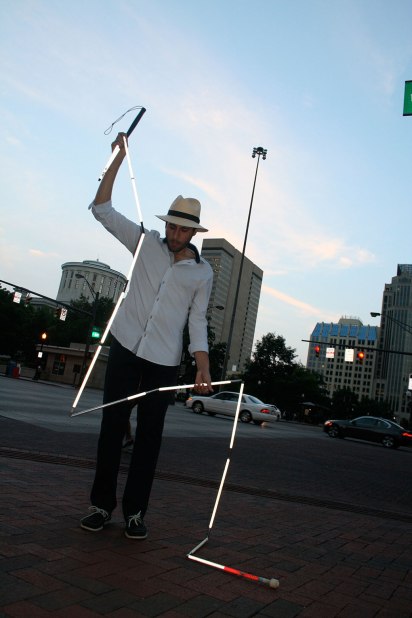Francis Alÿs is a Mexico-based artist who’s work encompasses a variety of media, often performances that are documented by video, photography, writing, painting, and animation. His work is described as poetic and political, as he often examines the social, cultural, and political conditions of the land.
The Green Line (Jerusalem, 2004)
SOMETIMES DOING SOMETHING POETIC CAN BECOME POLITICAL
and
SOMETIMES DOING SOMETHING POLITICAL CAN BECOME POETIC

Another politically charged walk is “The Green Line“, where Francis Alÿs walks the Armistice border in Jerusalem carrying a leaking can of green paint that trails a line behind him as he walks. The title of the work, and the green line itself, are references to the historic Green Line that was agreed upon in 1949 as the boundary between Israeli and Palestinian land at the end of the 1948 Arab-Israeli war. After the war had resulted in a clear win for Israel, the Israeli state was established and a green line was literally drawn out on a map to demarcate its borders with Egypt, Palestine, Syria and Lebanon during the Armistice Agreements.
Sometimes Making Something Leads to Nothing (Mexico City 1997)


His walks are often location based and can be simply about the city. In a well known piece titled “Sometimes Making Something Leads to Nothing“, Alÿs pushes a large block of ice around Mexico City for over 9 hours until it melts away. The piece transforms into a way of getting to know the city from a different perspective.
Samples II (London, 2004)
Similarly, inn “Samples II”, Alÿs walks around London, England with a drum stick in his hand, playing the sounds of metal fences beside him.
These two walks also reference another theme of his work. Francis Alÿs has a series of works that explore the kinds of games that children play where they live. In another video, he documents the same action for the fencing around Fitzroy Square specifically.
Children’s Games (Worldwide, 1999-present)
His series, “Children’s Games” contains video documentation of the games children play all around the world including Mexico, Afghanistan, France, Belgium, Venezuela, and Morocco. The games are usually ones involving a group of children outside with, playing with bought toys or found items such as kites, marbles, water bottles, sticks, coins, old bike tires, and even broken pieces of mirror.


Francis Alÿs references this interest in children’s games in different bodies of work. A theme that often comes up in his work is the task of doing, undoing, and not doing.
Reel/Unreel (Kabul, Afghanistan 2011)
An example of this “doing and undoing” is Francis Alÿs’ video “Reel/Unreel“, where “the action takes place along the bare cityscape of Kabul, Afghanistan. The cameras follow a reel of film as it unrolls through the old part of town—pushed by two children, uphill and downhill, like a hoop, inspiring an improvised narrative”
“On the 5th of September 2001, the Taliban confiscated thousands of reels of film for the Afghan Film Archive and burned them on the outskirts of kabul. People say the fire lasted 15 days. But the Taliban didn’t know they were mostly given film print copies which can be replaced and not the original negatives, which cannot.”
When Faith Moves Mountains (Lima, Peru 2002)

In “When Faith Moves Mountains“, Francis Alÿs congregates 500 volunteers to shovel a large dune on the outskirts of Lima, Peru to be moved 10 cm from its original location. Over the course of a day, the volunteers move the surface of the dune over, accomplishing an overall un-recognizable event. The principle for the action was “maximum effort, minimal result”, but the social aspect of requiring many people provides a great sense of achievement.
Re-enactments (2001)

On November 4, 2000, Francis Alÿs illegally purchased a gun from a shop in downtown Mexico City. He then left the shop, loaded gun in hand, and walked through the streets of the city. Twelve and a half minutes later, Alÿs was pursued by the police – he was quickly apprehended, pinned against the police car, searched, and taken away for his arrest. This event constituted the first part of Alÿs’s Re-enactments (2001) – a work in which the artist sought to execute a performance and then carefully recreate it based on the documentation of the performance.
The script was simple: he was to buy the gun and move through the streets until something occurred to interrupt him. Alÿs’s initial performance, from his first grasp of the gun until his arrest, was filmed by his collaborator, artist Rafael Ortega, and this footage became the basis for the performance’s reproduction. Alÿs and Ortega replicated the initial performance the same day, a project only possible because Alÿs managed to evade punishment for his crime. Alÿs was able to both negotiate his release from police custody – ostensibly through bribery, a common practice in negotiating with the police in Mexico City – and persuade the officers to participate in the staging of the second performance. In the re-enactment of the performance, the policemen acted out their roles in the scene of Alÿs’s arrest. This time, however, Alÿs used a fake gun and Ortega took a significantly different approach to filming the performance. In the two-channel video, the footage of Alÿs’s performances are juxtaposed; labeled “Real” and “Re-enactment,” they play simultaneously, comparing the footage of the initial performance and its recreation. (http://ivc.lib.rochester.edu/performing-the-document-in-francis-alyss-re-enactments-2001/)


Magnetic Shoes, 1994
Alÿs spent several days walking around Havana with magnetic shoes for the 1994 Biennial, collecting metallic refuse along the way, and in doing so, he actively brought the city into focus.















 A Line Made by Walking, 1967
A Line Made by Walking, 1967





















You must be logged in to post a comment.